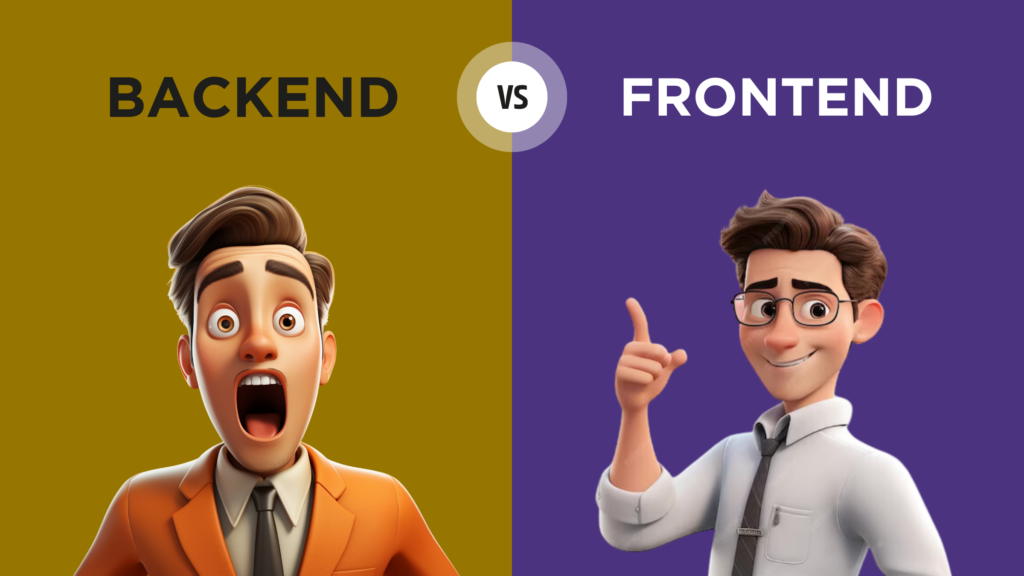Table of Contents
Introduction 🚀:
When you open your favorite website or app, have you ever wondered how it works? Well, behind the scenes, there are two superhero teams making it all happen – frontend and backend developers. These are the creative artists 🎨 and the logical thinkers 💻, working together to bring the internet to life. Let’s take a friendly stroll through the simple world of frontend and backend development and understand how they team up to make our online experiences enjoyable.
Frontend Development 🌈:
Imagine the frontend as the front door of a house 🏠. It’s what you see and touch – the colors, buttons, and pictures on a website. The folks working on the frontend use languages like HTML, CSS, and JavaScript. HTML is like the structure of a page, CSS gives it style, and JavaScript adds the magic to make things move and interact.
Frontend developers care a lot about making websites look good on your phone 📱, tablet, or computer 💻. They use cool tools like Bootstrap and React to help them do this easily. The goal is to make sure you have a fun and easy time clicking and swiping around.
Backend Development 🔧:
Now, let’s peek behind that front door. That’s where the backend magic happens. Think of the backend as the kitchen 🍳 – it’s where all the cooking and organizing take place. The backend deals with data, processes your requests, and makes sure everything runs smoothly.
Backend developers use languages like Python or PHP to build the kitchen, and they have helpers called databases (like a digital pantry) to store and find information. When you search for something on a website, the backend knows where to look and fetches the right stuff.
Working Together 🤝:
Imagine a conversation between the frontend and backend like friends passing notes in class. They need to talk to each other to make sure everything works. This talking happens through something called APIs – it’s like a language they both understand. APIs help them share information so that when you click a button on the frontend, the backend knows what to do.
Challenges 🤔:
Both frontend and backend have some challenges to deal with. Frontend folks need to make sure the website looks good on all kinds of devices. It’s like making sure the party is fun for everyone, no matter what gadget they bring.
Backend folks have challenges too, like making sure the website can handle lots of people visiting at the same time. They also need to keep everything safe and secure, like making sure only the right people get access to certain parts of the kitchen.
The Future 🚀:
As time goes on, things get even cooler. Frontend and backend teams are always finding new and better ways to make websites and apps. They’re like scientists discovering new gadgets and toys to play with.
New ideas like single-page apps and fancy words like “progressive web apps” are becoming popular. It’s like the teams are always inventing new things to make the internet more awesome for you!
Conclusion 🎉:
Now, which one is better? Well, it’s like asking if peanut butter is better than jelly – they’re both awesome, especially when they come together! Frontend and backend need each other to create a fantastic website.
If you want a job that lets you play with designs and make things look pretty, go for frontend. If you’re passionate about coding, solving problems, and making sure everything runs smoothly, go for backend. But here’s the secret – you can love both!
So, in the end, the answer is both are equally important. It’s not about choosing one over the other. It’s about finding what you enjoy doing more. Whether you’re the artist making things look cool or the coder making things work seamlessly, both frontend and backend are like best friends creating the internet magic we all love! 🌐✨
Distinguish between frontend and backend 💻:
| Aspect | Frontend | Backend |
|---|---|---|
| Responsibility | Deals with the user interface and design. | Manages server-side operations and data processing. |
| Languages | HTML, CSS, JavaScript | Python, Ruby, Java, PHP, etc. |
| Focus | User experience, design, and interactivity. | Server logic, database management, and server-side scripting. |
| Tools & Frameworks | Bootstrap, React, Angular, Vue.js | Django, Ruby on Rails, Express.js, Flask, etc. |
| Concerns | Browser compatibility, responsive design. | Scalability, security, and data management. |
| Communication | Uses APIs to communicate with the backend. | Responds to frontend requests through APIs. |
| Job Role | Well-suited for those with creative design skills. | Ideal for those passionate about programming and coding. |
| Visible Components | UI elements, layouts, buttons, and user interactions. | Database structures, server-side logic, and data handling. |
| Examples | Buttons, forms, and visual elements on a webpage. | Server, database, and the logic that makes a website work. |
Remember, both frontend and backend are essential parts of web development, working together to create a complete and functional website or application.

2 Comments
Pingback: Mastering Web Development: Your Ultimate Roadmap to Success | Coding Stella
Pingback: Backend Developer Skills: Definition, Languages & Examples | Coding Stella